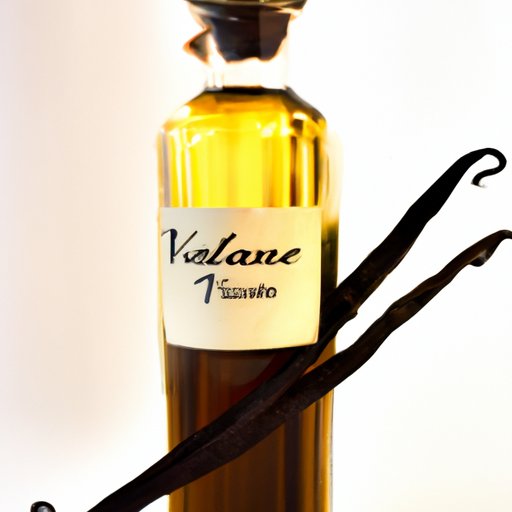Introduction
Vanilla extract is a beloved ingredient in kitchens around the world. Used in everything from baked goods to savory dishes, it has become a staple in many culinary contexts. But what is vanilla extract made of, and where does it come from? In this article, we will explore the science behind vanilla extraction, the journey of vanilla from bean to bottle, the cultural and historical significance of this versatile ingredient, and the potential for sustainability and ethical practices in its production. By the end of this article, you’ll be a vanilla extract expert!
The Science of Vanilla: Understanding the Extraction Process and Natural Ingredients
Vanilla extract is made by extracting the flavor from vanilla beans. Vanilla beans contain a variety of natural compounds that contribute to the flavor and aroma of vanilla extract, including vanillin, coumarin, and eugenol. These compounds are extracted from the beans using a variety of techniques, including solvent extraction, cold maceration, and heat extraction. Regardless of the technique used, the end result is a liquid that contains the essential flavor and aroma of vanilla.
The natural ingredients in vanilla extract are what give it its distinct and desirable flavor. Vanillin, in particular, is responsible for much of the flavor profile of vanilla extract. It has a sweet, creamy, and slightly floral taste that is unmistakable. Coumarin and eugenol, while present in smaller amounts, also contribute to the overall flavor and aroma of vanilla extract.
From Bean to Bottle: Tracing the Journey of Vanilla Extract Production
The journey of a vanilla bean from cultivation to its use in vanilla extract is a long and complex process. Vanilla beans are grown in tropical regions around the world, including Madagascar, Mexico, and Tahiti. Once harvested, they must be carefully processed and cured before they can be used in vanilla extract. The beans are typically blanched, sweated, and dried over a period of several months to bring out their natural flavor and aroma.
Once the beans are dried, they are ready to be used in vanilla extract production. There are a variety of techniques and ingredients used by vanilla extract producers, but the most common method is to steep the beans in alcohol. This allows the natural flavor and aroma of the beans to be extracted and concentrated into a liquid form.
It is important to note that not all vanilla extract is created equal. The quality of the beans, as well as the processing techniques used, can have a significant impact on the final product. High-quality vanilla extract is made from pure, natural ingredients and is carefully processed to ensure that the flavor and aroma of the beans is preserved.
The History and Culture of Vanilla Extract: A Look into the Origins and Significance of this Multi-Purpose Ingredient
Vanilla has a rich history that goes back thousands of years. It was first cultivated by the Totonac people of Mesoamerica, who used it for both medicinal and culinary purposes. The Aztecs later adopted it and introduced it to Spanish conquistadors, who brought it back to Europe where it became a highly sought-after commodity.
Today, vanilla is widely used in culinary contexts around the world. It has become a staple ingredient in everything from baked goods to ice cream to savory dishes. In many cultures, vanilla extract is also used for medicinal purposes, including as a natural remedy for headaches and digestive issues.
Exploring the Benefits and Uses of Vanilla Extract in Baking and Cooking
Vanilla extract is prized for its versatility and flavor profile. In baking, it adds a sweet, creamy, and slightly floral taste that pairs well with a wide range of ingredients. It is commonly used in cakes, cookies, and other sweet treats, as well as in custards and other creamy desserts.
Vanilla extract can also be used in savory dishes to add depth and complexity to the flavor. It pairs well with meats, vegetables, and grains, and can be used in everything from marinades to soups to sauces.
It is important to note that not all vanilla extract is created equal. Pure, high-quality vanilla extract is essential for achieving the best results in cooking and baking. Artificial vanilla flavorings simply do not have the same complexity or depth of flavor as natural vanilla extract.
A Vanilla Revolution: Exploring Alternate Methods and Ingredients for Making Vanilla Extract
While the traditional method for making vanilla extract involves steeping vanilla beans in alcohol, there are also alternative methods and ingredients that can be used. For example, some producers use an alternative bean, such as Tahitian vanilla, which has a slightly different flavor profile than traditional Madagascar vanilla.
Other producers use different flavoring agents to enhance the flavor of vanilla extract, such as wood chips or other natural extracts. While these alternative methods can produce unique and interesting flavor profiles, they may also lack the complexity and depth of traditional, pure vanilla extract.
Rethinking Vanilla Extract: Examining its Environmental and Social Impact
As the demand for vanilla extract has increased, so too have the challenges facing vanilla extract producers. Cultivation and production of vanilla beans can have significant environmental and social impacts, particularly in developing countries where labor standards may not be as strict.
However, there are also opportunities for sustainability and ethical sourcing of vanilla beans. By supporting producers who use sustainable farming practices and ethical labor practices, consumers can ensure that they are making a positive impact on the environment and local communities.
Conclusion
Vanilla extract is a beloved ingredient that has a fascinating history and culture behind it. By understanding the science of vanilla extraction, the journey of vanilla from bean to bottle, and the potential for sustainability and ethical sourcing, we can all be more informed and conscientious consumers. Whether you’re an avid baker or a savory cook, high-quality vanilla extract is an essential ingredient that can add depth and complexity to your dishes.
